Art
Explore some of the fantastic objects related to art at the Horniman in this learning resource.
- Use images from objects located in different galleries and in the Gardens to create a challenge or simple trail through the Museum to find specific objects or places.
- Use object images to encourage independent research, for instance, find out and write down three facts about an object or group of objects. Alternatively, give facts or clues and challenge your pupils to identify mystery objects.
- Set an alphabetical challenge ie find or draw 26 objects one for each letter of the alphabet.
- Create a sketchbook challenge.
Please note that our Natural History Gallery is now closed as part of a major 2 year redevelopment, Nature + Love. The rest of our galleries, displays and gardens will be open as usual, with plenty across the site to support your topic (including our Music and World Galleries).
Due to the gallery closure, the nine-banded armadillo in this resource is no longer on display.
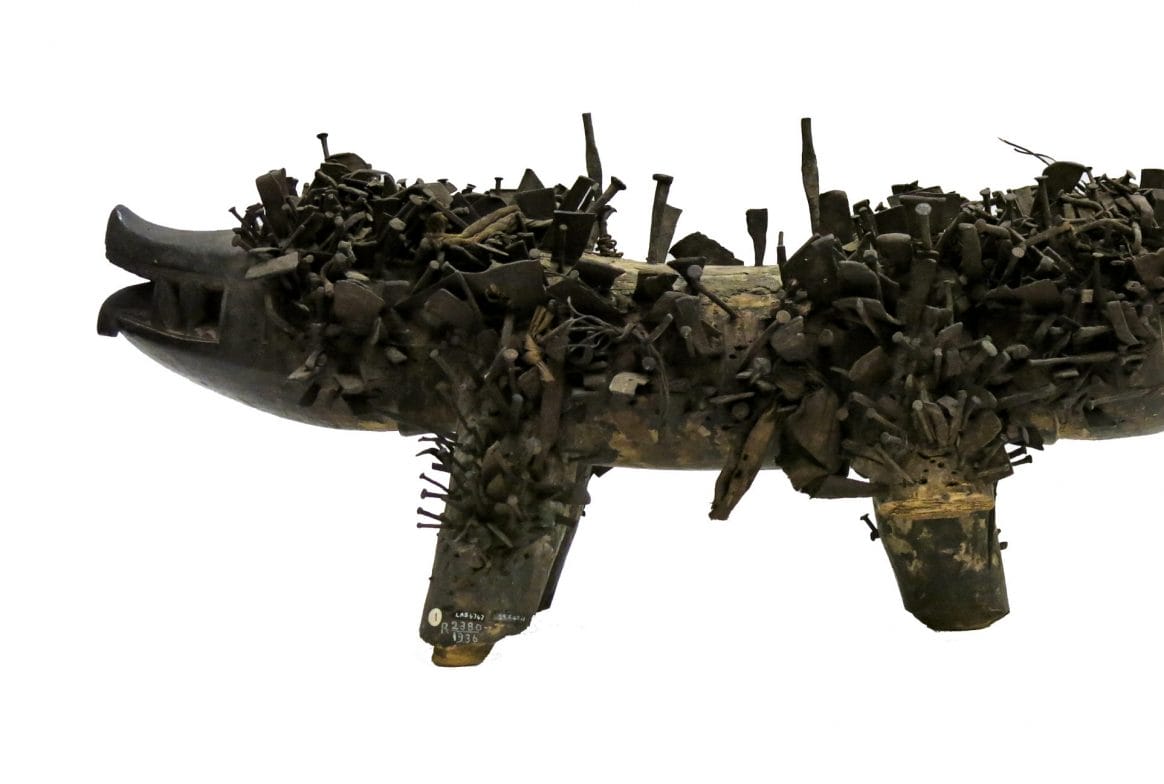
Ritual figure
This wooden sculpture is known as a nkisi (power figure). Many were made in the Democratic Republic of the Congo at the turn of the 20th century. They are used during rituals to heal, protect or inflict injury on certain people.
Minkisi (plural) come in several forms, such as a pot, jar or human or animal figure. This example is a two-headed dog, Nkisi Kozo. It is known for hunting witches and is considered the mediator between the land of the living and the land of the dead because it lives in the villages but at night hunts in the forests (where the dead live).
Being able to see both worlds, people believe that the dogs have four eyes, which is why some have two heads, as visible here. Nails were driven into the figure to bring spirits into action.
How has the sculptor made this object look powerful?
Minkisi (plural) come in several forms, such as a pot, jar or human or animal figure. This example is a two-headed dog, Nkisi Kozo. It is known for hunting witches and is considered the mediator between the land of the living and the land of the dead because it lives in the villages but at night hunts in the forests (where the dead live).
Being able to see both worlds, people believe that the dogs have four eyes, which is why some have two heads, as visible here. Nails were driven into the figure to bring spirits into action.
How has the sculptor made this object look powerful?
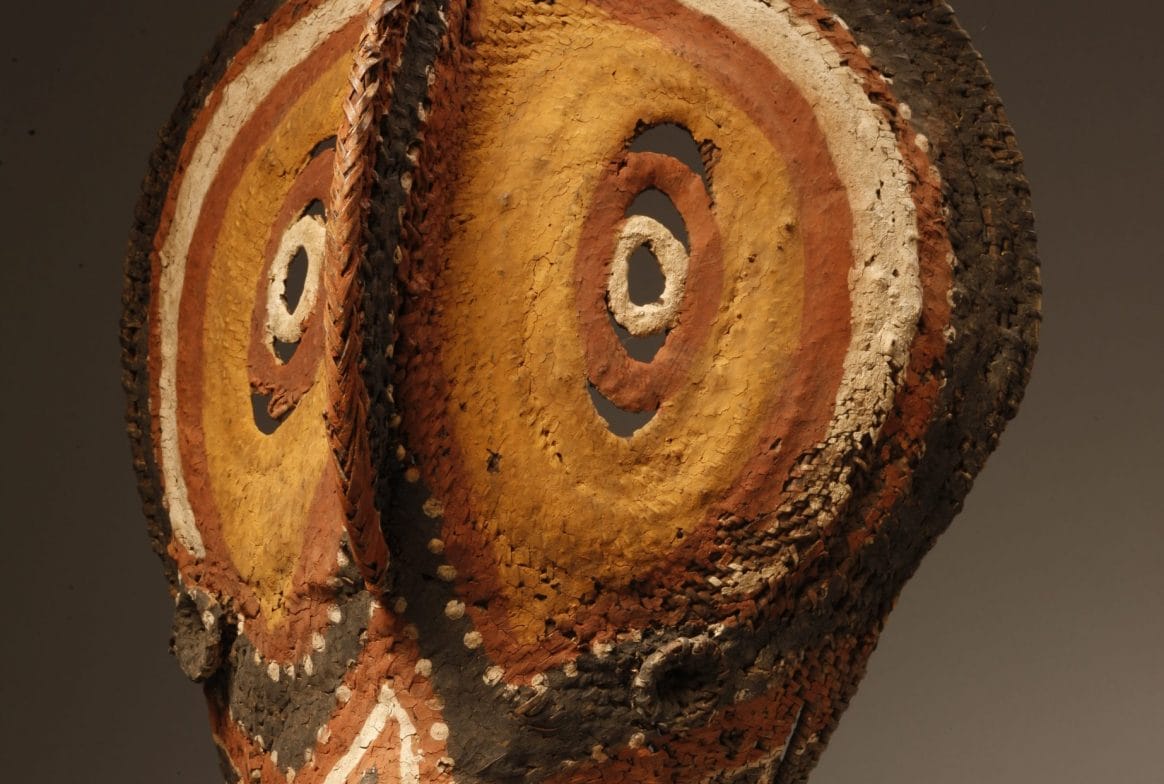
Mask
This mask was never worn by a person. It is an Abelam yam mask (baba-tagwa) made from coiled basketry covered with gum and painted.
The Abelam people in the Sepik region of Papua New Guinea grow two types of yams (a root vegetable) – smaller ones to eat and larger ones for ceremonies.
Each initiated man in the village has a trading partner from another village, and they compete to grow the largest yam. The yams are tended carefully and sometimes carried like babies. In Abelam language, ‘to plant a yam’ also means ‘to bury a dead person’.
For the presentation ceremony, the yams are decorated with specially made masks named after ancestors and displayed in front of the meeting house of the host village. The men exchange yams and the one with the largest yam is considered the better man.
How would you describe the mask’s expression?
The Abelam people in the Sepik region of Papua New Guinea grow two types of yams (a root vegetable) – smaller ones to eat and larger ones for ceremonies.
Each initiated man in the village has a trading partner from another village, and they compete to grow the largest yam. The yams are tended carefully and sometimes carried like babies. In Abelam language, ‘to plant a yam’ also means ‘to bury a dead person’.
For the presentation ceremony, the yams are decorated with specially made masks named after ancestors and displayed in front of the meeting house of the host village. The men exchange yams and the one with the largest yam is considered the better man.
How would you describe the mask’s expression?
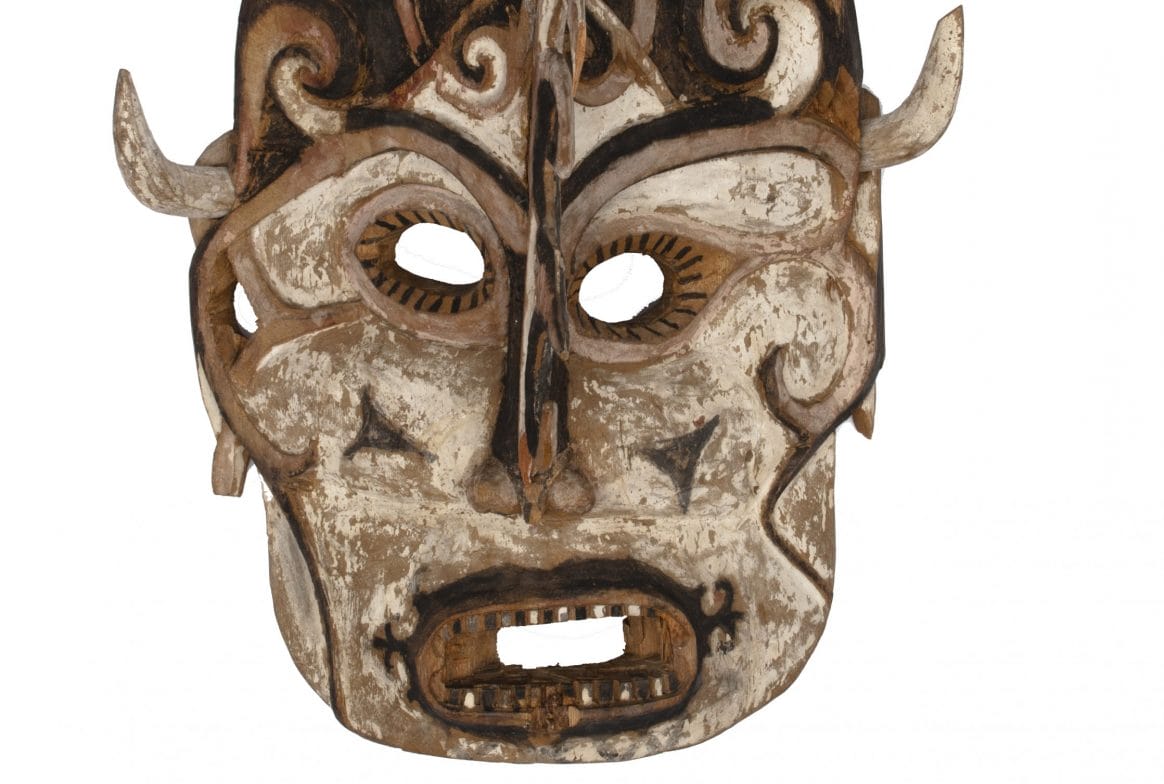
Mask
Are you frightened?
This Sarawak mask from Malaysia is thought to represent Indai Guru, a female spirit who the Dayak people believed lurked in lofts and far corners of their houses. It is made from carved wood and painted mostly white and features striking curled motifs to the sides of the face and across the forehead.
Traditional ceremonial masks from the Sarawak region were used to serve different ritualistic purposes, for example celebrating a good harvest or exorcising evil spirits. It is believed this mask was used to frighten naughty children. How has the maker given the mask a frightening appearance?
This Sarawak mask from Malaysia is thought to represent Indai Guru, a female spirit who the Dayak people believed lurked in lofts and far corners of their houses. It is made from carved wood and painted mostly white and features striking curled motifs to the sides of the face and across the forehead.
Traditional ceremonial masks from the Sarawak region were used to serve different ritualistic purposes, for example celebrating a good harvest or exorcising evil spirits. It is believed this mask was used to frighten naughty children. How has the maker given the mask a frightening appearance?
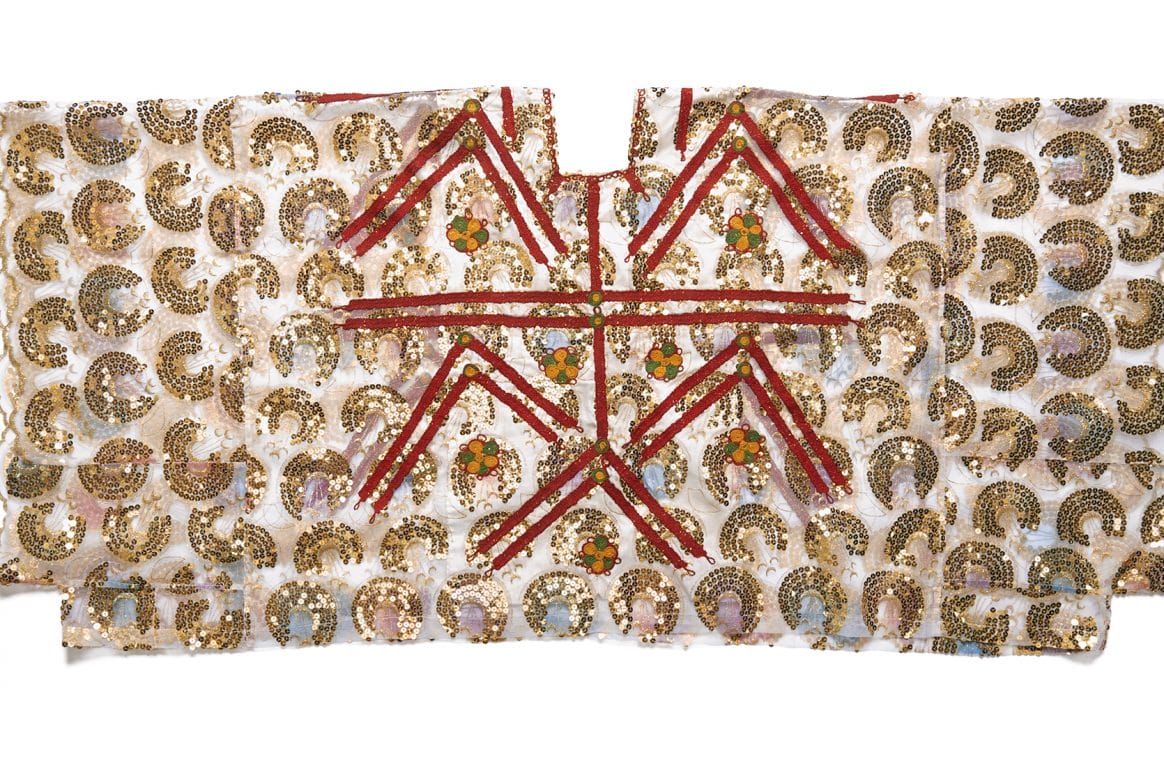
Tuareg blouse
This woman’s outfit from 2007 was known as Feu de Rhissa (fire of Rhissa) in Agadez, Niger. It was worn in support of Rhissa Ag Boula, leader of the Tuareg rebels against the government in the early 1990s.
The white blouse is covered with gold sequins and combines the traditional embroidery of the Tuareg people on the back and front in red. The sequins sparkle in the light and are said to represent the sparks of fire ignited by Rhissa Ag Boula as he campaigned for Tuareg independence.
The feu de Rhissa garment appeared during the first rebellion and was considered a very expensive garment as well as a symbol of resistance. Can a garment be both rebellious and beautiful? What else do people wear to show their political support?
The white blouse is covered with gold sequins and combines the traditional embroidery of the Tuareg people on the back and front in red. The sequins sparkle in the light and are said to represent the sparks of fire ignited by Rhissa Ag Boula as he campaigned for Tuareg independence.
The feu de Rhissa garment appeared during the first rebellion and was considered a very expensive garment as well as a symbol of resistance. Can a garment be both rebellious and beautiful? What else do people wear to show their political support?
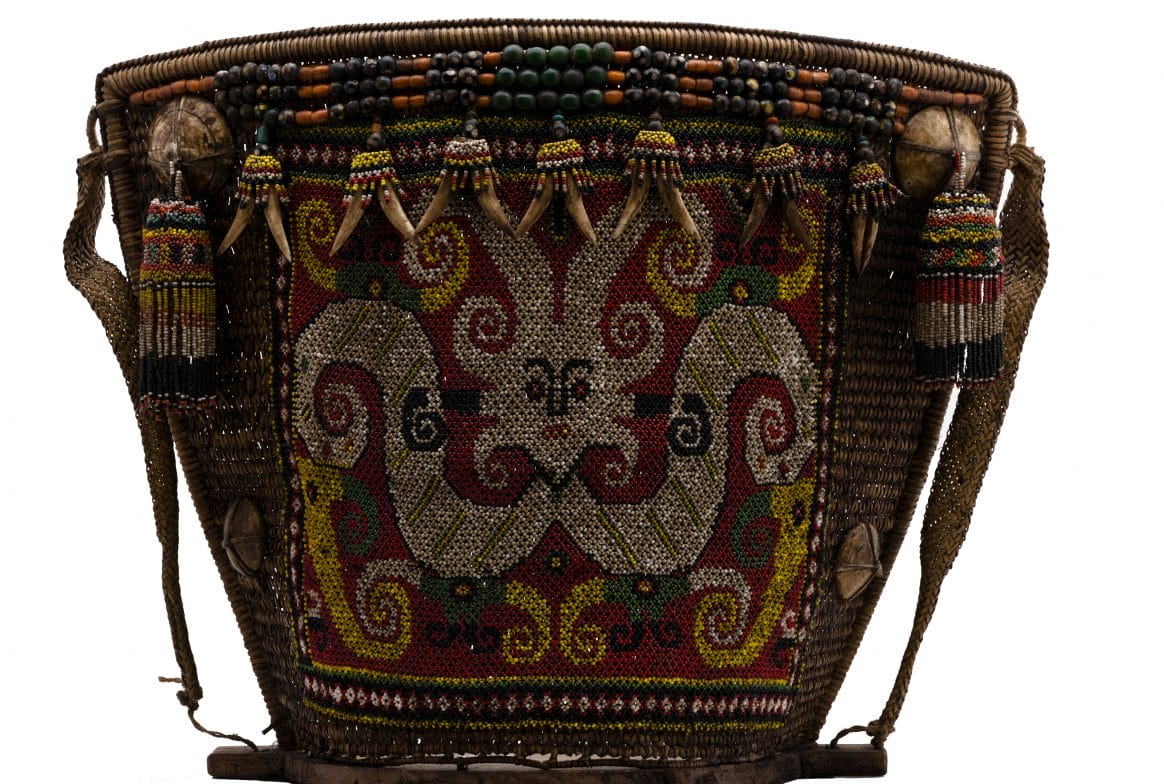
Baby carrier
This is a Dayak baby carrier from Borneo, known as a ba. Resembling small chairs without legs, ba are supported on the mother’s shoulders from straps.
The seat is made of a semi-circular plank to which the woven basketry back is attached, decorated with a panel (aban) of coloured glass beads. This type of beadwork is a traditional Kayan Dayak art, made by women. An aban often shows powerful protective symbols such as ancestors and dragons, to guard the baby against evil spirits.
This example shows a stylized human face with curving tendril-like motifs typical of Kayan Dayak art. The tassels at the top contain animal teeth, which suggests that this carrier may have been for a boy.
How is gender represented in babywear in Britain? Is this changing?
The seat is made of a semi-circular plank to which the woven basketry back is attached, decorated with a panel (aban) of coloured glass beads. This type of beadwork is a traditional Kayan Dayak art, made by women. An aban often shows powerful protective symbols such as ancestors and dragons, to guard the baby against evil spirits.
This example shows a stylized human face with curving tendril-like motifs typical of Kayan Dayak art. The tassels at the top contain animal teeth, which suggests that this carrier may have been for a boy.
How is gender represented in babywear in Britain? Is this changing?
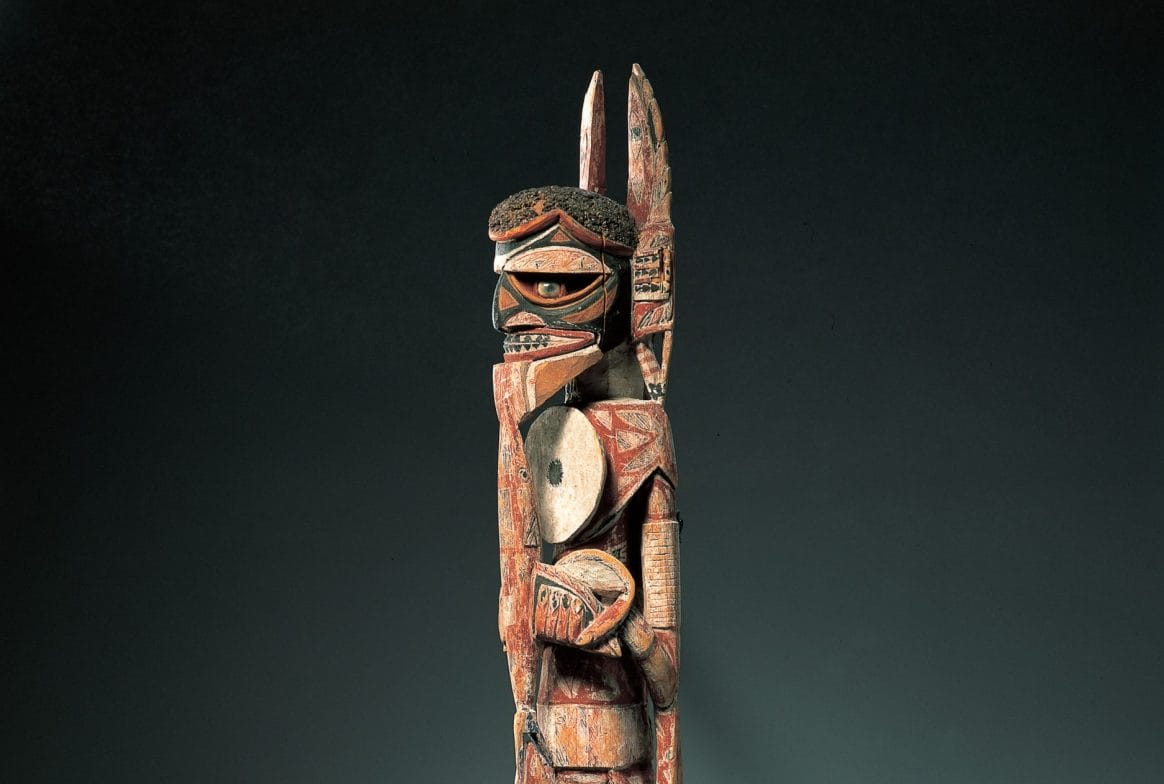
Ancestor post
Sculpture was central to traditional mourning in New Ireland, Papua New Guinea.
This ancestor post or marumarua was made for a funeral ceremony. It contains the life force of a deceased person. The design is not meant to be a portrait of the deceased, but an idealised image of the ancestor that a person’s spirit will become.
Months or even years later, a second ceremony called a malangan freed the dead person to the afterlife. These sculptures were taken into the forest to rot.
During their lives, New Irelanders gain rights to one or more of the vast variety of designs. Carvers draw upon inherited clan designs and inspiration from their own dreams.
This post shows a human-like figure wearing a large kapkap shell ornament on his chest, with a number of fish (likely flying fish) swimming upwards from his feet towards his head. What do you think these symbolise?
This ancestor post or marumarua was made for a funeral ceremony. It contains the life force of a deceased person. The design is not meant to be a portrait of the deceased, but an idealised image of the ancestor that a person’s spirit will become.
Months or even years later, a second ceremony called a malangan freed the dead person to the afterlife. These sculptures were taken into the forest to rot.
During their lives, New Irelanders gain rights to one or more of the vast variety of designs. Carvers draw upon inherited clan designs and inspiration from their own dreams.
This post shows a human-like figure wearing a large kapkap shell ornament on his chest, with a number of fish (likely flying fish) swimming upwards from his feet towards his head. What do you think these symbolise?
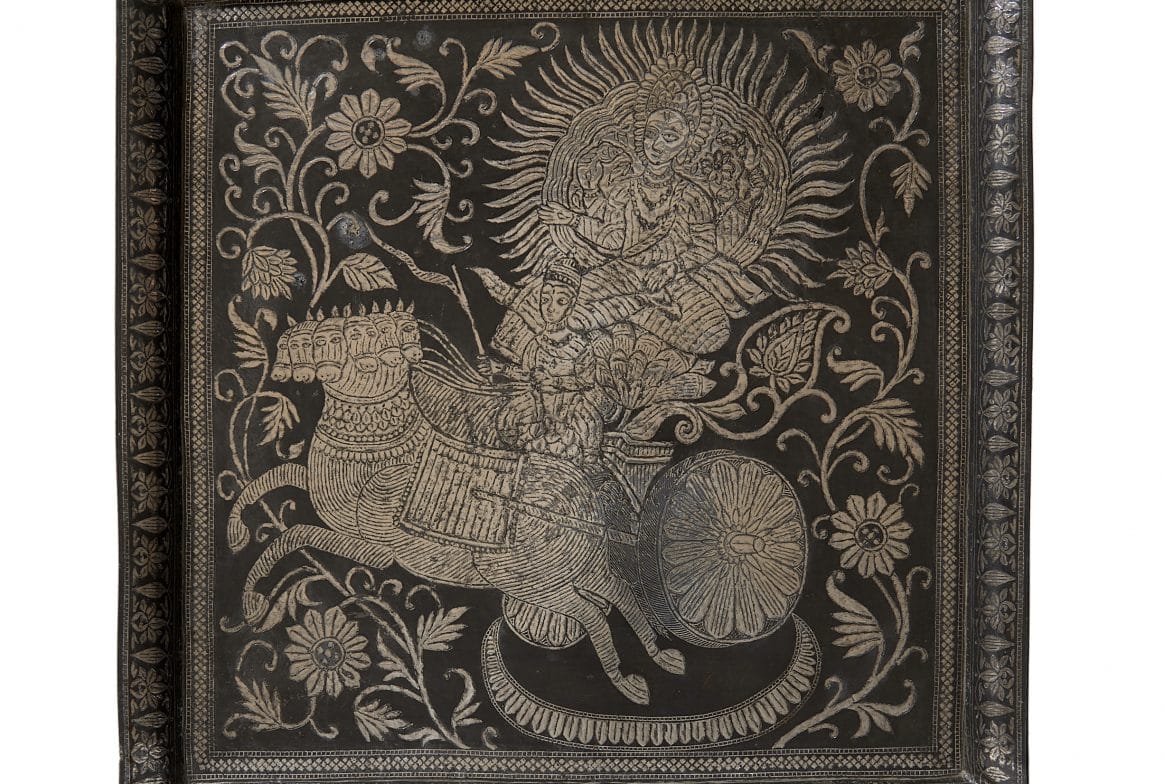
Decorative plate
This decorative plate is a fine example of Bidriware; a metal handicraft named after the Indian town of Bidar.
The craft developed in India in the 14th Century, possibly earlier. A renowned metal technique using zinc inlaid with silver, Bidriware is still highly valued today.
Bidriware has eight stages of processing, notably including soil from the ruins of Bidar fort, which oxidises well to produce a lustrous black colour.
This example is decorated with lotus flowers and bats on the rim. The central decoration shows Hindu deities, Surya the illuminator and Savitri the creator, riding a chariot drawn by six horses.
Traditional designs include geometric shapes, flowers and poppies. Inlaying is an Islamic technique so it is unusual to see Hindu figures on Bidriware.
There has been a modern resurgence in Bidriware with innovative designs and patterns featuring Indian to global themes being introduced – on wide-ranging accessories including USB sticks!
The craft developed in India in the 14th Century, possibly earlier. A renowned metal technique using zinc inlaid with silver, Bidriware is still highly valued today.
Bidriware has eight stages of processing, notably including soil from the ruins of Bidar fort, which oxidises well to produce a lustrous black colour.
This example is decorated with lotus flowers and bats on the rim. The central decoration shows Hindu deities, Surya the illuminator and Savitri the creator, riding a chariot drawn by six horses.
Traditional designs include geometric shapes, flowers and poppies. Inlaying is an Islamic technique so it is unusual to see Hindu figures on Bidriware.
There has been a modern resurgence in Bidriware with innovative designs and patterns featuring Indian to global themes being introduced – on wide-ranging accessories including USB sticks!

Shadow puppet
This shadow puppet represents Reusi, the Hermit, who appears in all shadow puppet performances in Thailand. He is considered to have religious and magical powers and seen as the protector of the puppeteers.
The shadow puppet is made of parchment decorated with yellow, red, and green ink & pierced with decorative holes. The skin is black and the feet are bare. One free hand holds a crooked staff with a bird's head handle. The other hand holds a leaf-shaped fan.
Outside the royal court, shadow puppets from the Nang Talung tradition are used to tell the Ramakien story, which is taught at school to Thai children. Many British school children learn the Indian story Ramayana (or ‘Rama and Sita’), which is what the story of Ramakien is based on.
The shadow puppet is made of parchment decorated with yellow, red, and green ink & pierced with decorative holes. The skin is black and the feet are bare. One free hand holds a crooked staff with a bird's head handle. The other hand holds a leaf-shaped fan.
Outside the royal court, shadow puppets from the Nang Talung tradition are used to tell the Ramakien story, which is taught at school to Thai children. Many British school children learn the Indian story Ramayana (or ‘Rama and Sita’), which is what the story of Ramakien is based on.
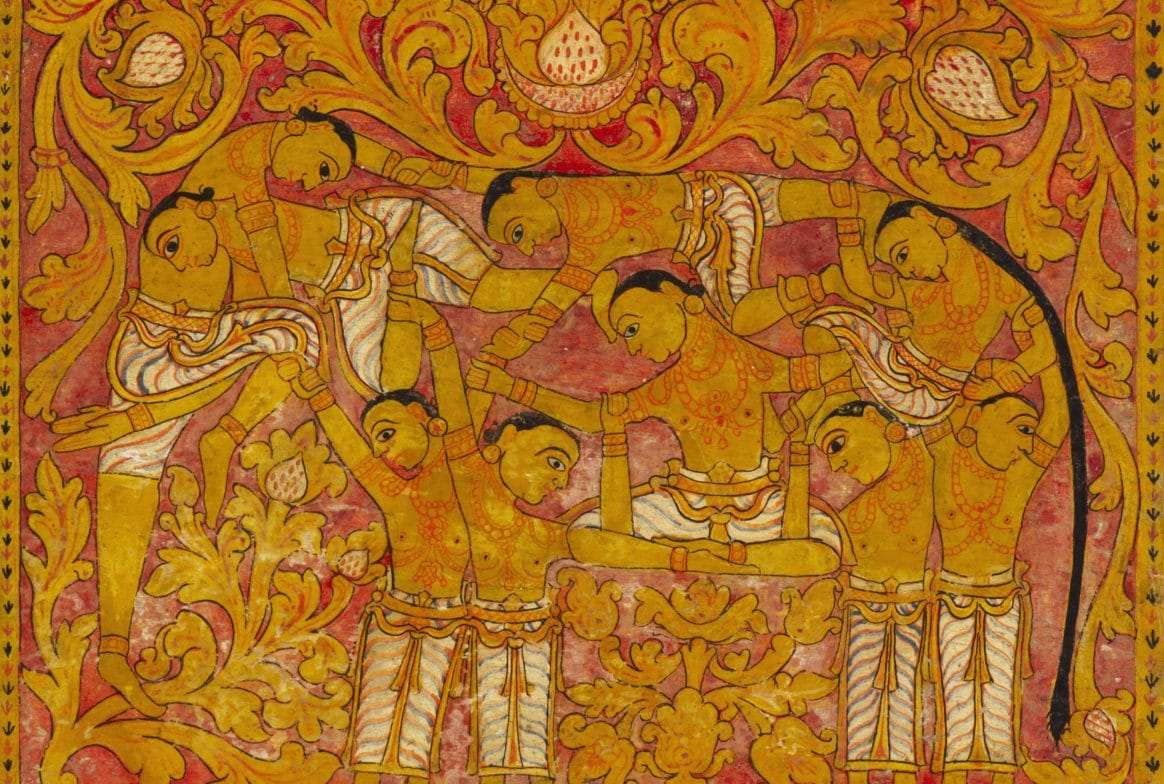
Decorated panel
This wooden panel is decorated with nine human figures formed into the shape of an elephant.
The figures are shown in various positions around a central woman sitting in lotus position (padmasana). The figures are surrounded by plants.
This is an apprentice’s work, as exercises that young artists in Sri Lanka were taught to master included the panca-nari-geta (5-women-knot) and the sat-nari-torana (6 women arch). Can you think of technical exercises that art students have to master? Have you mastered any?
The figures are shown in various positions around a central woman sitting in lotus position (padmasana). The figures are surrounded by plants.
This is an apprentice’s work, as exercises that young artists in Sri Lanka were taught to master included the panca-nari-geta (5-women-knot) and the sat-nari-torana (6 women arch). Can you think of technical exercises that art students have to master? Have you mastered any?
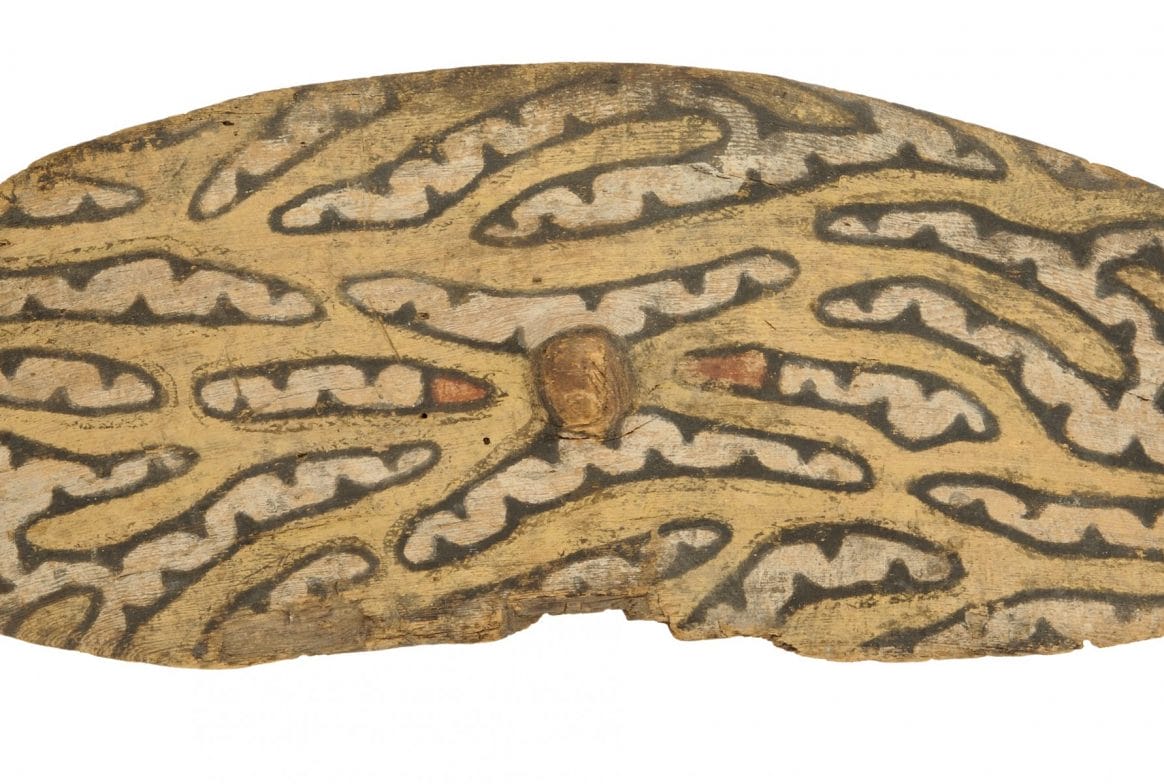
Painted war shield
This shield from the early 20th Century was made and used by the Rainforest peoples, in the Cairns/Cardwell region of far north Queensland, Australia.
Carved out of the root of a Giant Fig tree, the shield is painted with an asymmetrical pattern of curved zigzags.
Shields like this are among the best-known Aboriginal artefacts from Queensland. They were used in warfare, and in ceremonial duels. These duels took place in the event of arguments between older men, during the initiation of young men, and when a groom went to collect his future wife.
The paint was made from a mixture of mineral pigment, charcoal and the artist’s blood. A shield’s decoration gave it powerful protective forces. Common designs including animals, boomerangs and elements of important places known as ‘Dreaming Sites’.
Does the pattern remind you of any structures in plants or animals?
Carved out of the root of a Giant Fig tree, the shield is painted with an asymmetrical pattern of curved zigzags.
Shields like this are among the best-known Aboriginal artefacts from Queensland. They were used in warfare, and in ceremonial duels. These duels took place in the event of arguments between older men, during the initiation of young men, and when a groom went to collect his future wife.
The paint was made from a mixture of mineral pigment, charcoal and the artist’s blood. A shield’s decoration gave it powerful protective forces. Common designs including animals, boomerangs and elements of important places known as ‘Dreaming Sites’.
Does the pattern remind you of any structures in plants or animals?
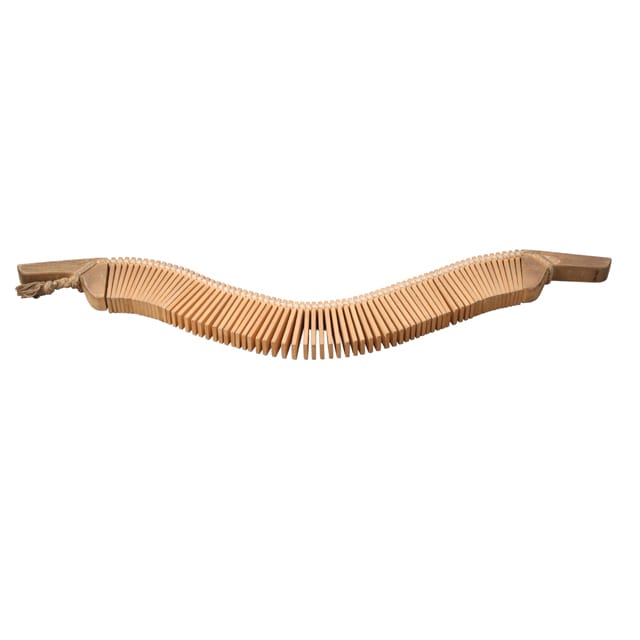
Strung rattle
This strung rattle from Kurashiki or Honshu, Japan, is known as a Binzasara, a traditional Japanese percussion instrument that was used to produce rhythms for folk songs, rural dances and the off-stage orchestra in rice-planting scenes in the Kabuki theatre.
The instrument is made of small slats of wood strung together with a cotton cord. The rattle is played by moving the leather handles in a wave motion to produce a sound when the wooden slats clap together.
Kabuki theatre was one of the most popular dramatic forms of Japan and is thought to have originated in the 17th Century. The dialogue, lively action and dances were accompanied by singers and an orchestra. Traditional Kabuki plays lasted all day and included lunch and tea.
Even when it is stationary, the movement of this instrument is clear. Can you think of other objects that seem to move even when still?
The instrument is made of small slats of wood strung together with a cotton cord. The rattle is played by moving the leather handles in a wave motion to produce a sound when the wooden slats clap together.
Kabuki theatre was one of the most popular dramatic forms of Japan and is thought to have originated in the 17th Century. The dialogue, lively action and dances were accompanied by singers and an orchestra. Traditional Kabuki plays lasted all day and included lunch and tea.
Even when it is stationary, the movement of this instrument is clear. Can you think of other objects that seem to move even when still?
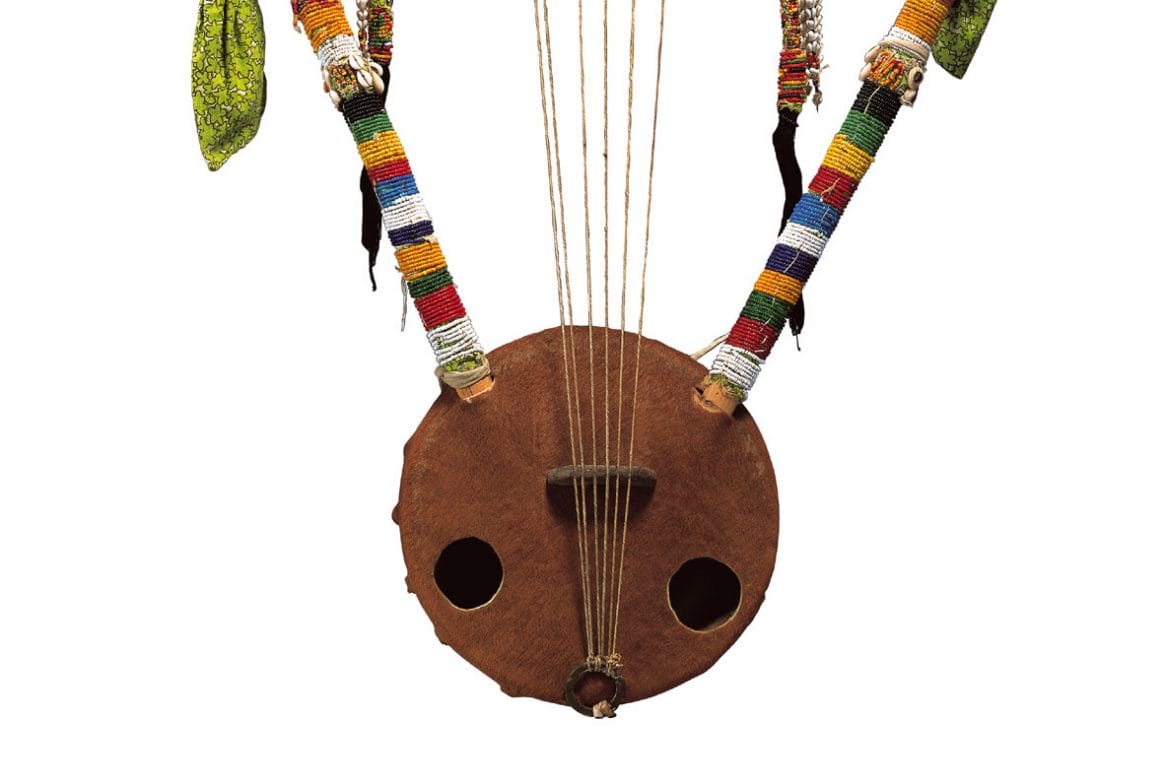
Rebaba lyre
This Rebaba, or bowl lyre, dates from around 1968.
The six strings run between the cross-bar and a metal ring at the base. The mammal-skin centre has two sound holes and is held tight by leather straps around the wooden resonator. It is elaborately decorated with beadwork, shells and mirrors.
The Rebaba is used in Zar ceremonies in Eritrea, North East Africa, which are exorcisms held to cure people who are diagnosed as being possessed by spirits. The lyre is believed to give instructions for the ceremony through its strings, which are interpreted by its player.
The mirrors on the crossbar and amulets in bags hanging from the lyre’s heavy frame are thought to have magical powers, fighting evil in the zar ceremonies. What kinds of sounds do you think might be played for this?
The six strings run between the cross-bar and a metal ring at the base. The mammal-skin centre has two sound holes and is held tight by leather straps around the wooden resonator. It is elaborately decorated with beadwork, shells and mirrors.
The Rebaba is used in Zar ceremonies in Eritrea, North East Africa, which are exorcisms held to cure people who are diagnosed as being possessed by spirits. The lyre is believed to give instructions for the ceremony through its strings, which are interpreted by its player.
The mirrors on the crossbar and amulets in bags hanging from the lyre’s heavy frame are thought to have magical powers, fighting evil in the zar ceremonies. What kinds of sounds do you think might be played for this?
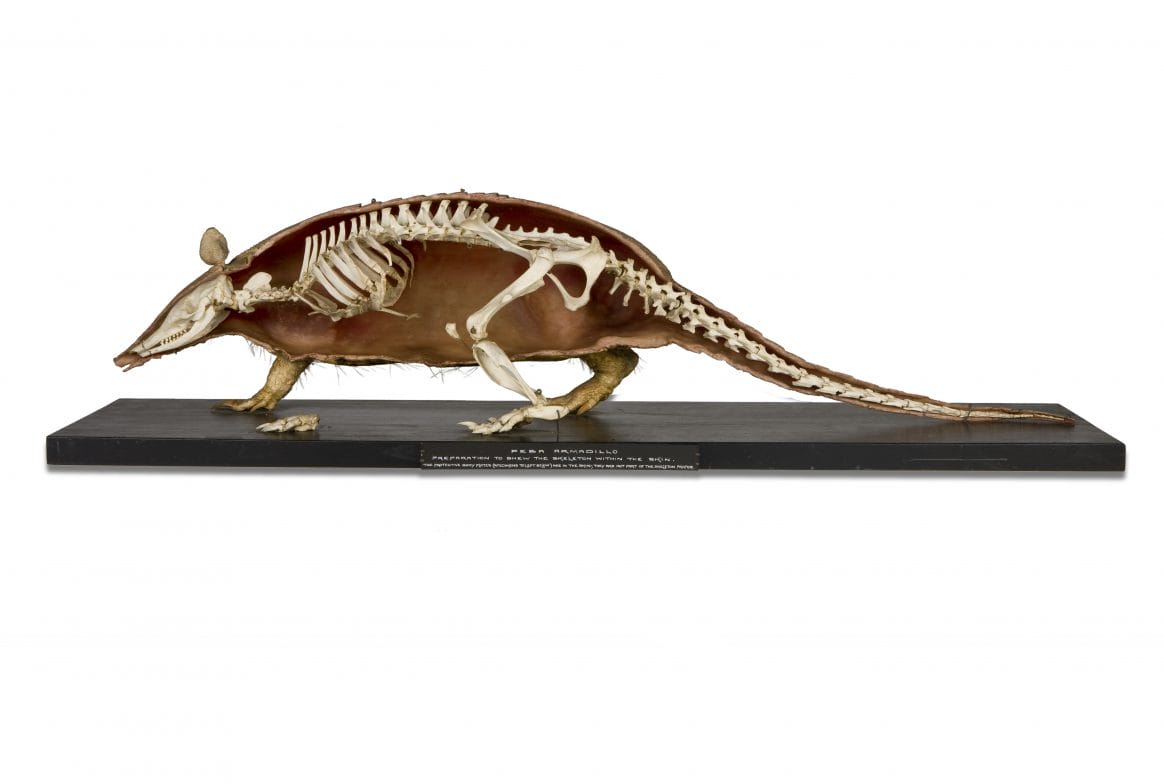
Nine-banded armadillo
Double Preparations or ‘doublepreps’ are inside-on-one-side, outside-on-the-other specimens, with skeletons covered on one side by their taxidermied skin.
Doublepreps were used as educational tools in the early 20th Century, as they reveal how an animal's inner structures fit inside the skin.
Some doublepreps, such as this nine-banded armadillo, have a red wax lining which indicates they were made by Schlüter of Halle, a German firm of natural history dealers, which supplied specimens to museums and private collectors worldwide.
The nine-banded armadillo has a striking pattern of armour, made up of scaly (scutes) covering its head, body and tail, and up to nine jointed bands on its mid-section that let it bend.
To accurately draw the outside of an animal, do you need to know what it looks like on the inside?
Doublepreps were used as educational tools in the early 20th Century, as they reveal how an animal's inner structures fit inside the skin.
Some doublepreps, such as this nine-banded armadillo, have a red wax lining which indicates they were made by Schlüter of Halle, a German firm of natural history dealers, which supplied specimens to museums and private collectors worldwide.
The nine-banded armadillo has a striking pattern of armour, made up of scaly (scutes) covering its head, body and tail, and up to nine jointed bands on its mid-section that let it bend.
To accurately draw the outside of an animal, do you need to know what it looks like on the inside?












